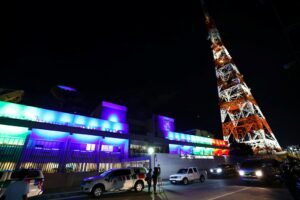Philippines approves emergency use of Covovax vs COVID-19

THE PHILIPPINES has approved the emergency use of the coronavirus vaccine made by US-based Novavax, Inc. for people aged 18 and above, its drug regulator said on Wednesday.
The Food and Drug Administration (FDA) issued the permit to the Covovax brand, which will be manufactured by Serum Institute of India, its chief Rolando Enrique D. Domingo told a televised news briefing.
Covovax, the ninth vaccine allowed for emergency use in the Philippines, replicates an antigenic part of the coronavirus to elicit immune response, Mr. Domingo said. The two-dose vaccine is 89.7% effective against the coronavirus.
The FDA chief said adverse effects caused by the vaccine in clinical trials were “very mild.”
In March, the Philippine government said it would sign a supply deal with Novavax for 30 million doses of the Covovax vaccine.
Novavax got its first emergency use authorization from Indonesia early this month. The company has filed an application for approval of its protein-based vaccine in Canada, the drugmaker said in a statement posted on its website.
The company has submitted all data and modules to a European Union agency in charge of evaluating medical products to support the final regulatory review of its application, it added.
Aside from Covovax, also approved for emergency use in the Philippines are the vaccines made by Sinovac Biotech Ltd, Russia’s Gamaleya Research Institute of Epidemiology and Microbiology, AstraZeneca Plc, Pfizer, Inc., Moderna, Inc., Johnson & Johnson, Bharat Biotech International Ltd., and Sinopharm.
The country, which began its vaccination program in March, has vaccinated more than a quarter of its adult population.
The Department of Health (DoH) reported 1,190 coronavirus cases on Wednesday, bringing the total to 2.82 million.
It said the death toll rose to 46,117 after 309 more patients died, even as it cited a delay in the reporting of virus-related deaths.
Of the 309 deaths, only 18 occurred this month, while 61% occurred last month due to late encoding of death information, the agency said…
Recoveries increased by 2,759 to 2.75 million. There were 23,846 active cases, 58.1% of which were mild, 5.2% did not show symptoms, 12% were severe, 19.6% were moderate and 5% were critical.
DoH said 34 duplicates had been removed from the tally, 33 of which were tagged as recoveries, while 264 recoveries were relisted as deaths. One laboratory failed to submit data on Nov. 15.
It added that 33% of intensive care units in the Philippines were occupied, while the rate for Metro Manila was 33%.
Meanwhile, the country’s seven-day average number of new coronavirus cases has declined by a tenth to 1,809, OCTA Research Group fellow Fredegusto “Guido” P. David tweeted.
The coronavirus reproduction number in the Philippines was 0.42, while its positivity rate was 4%, he added. “Based on these trends, new cases could decrease to 500 before the year’s end.”
Metro Manila’s seven-day average of new cases increased by 14% to 413, while its positivity rate remained at 3%, Mr. David said.
“I think it is just due to backlog,” he said. “I still don’t see a surge happening. I think the growth rate will be negative again next week”
Meanwhile, the government has approved a plan to resume physical university classes in areas with low coronavirus cases, according to the presidential palace.
Only fully vaccinated students and teachers would be allowed to attend face-to-face classes in areas under Alert Levels 1 to 3, acting presidential spokesman Karlo Alexei B. Nograles said in a statement.
The Commission on Higher Education, which proposed the plan, will “execute the phased implementation program to ensure the safe reopening of higher education campuses,” he said.
The reopening of classes will be allowed as long as room capacity is limited to 50% and local government give their consent, he said.
The first phase of limited face-to-face classes will start in December, while the second phase will begin in January.
Higher education institutions in areas under Alert Level 2 may apply for physical classes during the first phase, while universities in areas under Alert Level 3 may do so during the second phase.
These classes should follow the guidelines set by the Commission on Higher Education and Department of Health, Mr. Nograles said.
It should be done “alongside the continued implementation of proactive measures and restrictions that have been put in place to prevent the spread of COVID-19 (coronavirus disease 2019), and have contributed to the steady decline in COVID-19 cases in the country.”
The Cabinet official urged people “to work together to ensure the safety of our students.”
The Philippines is the last country to reopen schools physically since the coronavirus pandemic started last year.
The lockdown in Manila, the capital and nearby cities has been relaxed to the second alert level after the government struggled to contain a highly contagious Delta variant. — Kyle Aristophere T. Atienza




